Physical Address
304 North Cardinal St.
Dorchester Center, MA 02124
Malignant tumors of the uterine corpus can be divided into epithelial and mesenchymal types (sarcomas). In 2019, there were an estimated 61,880 cases of cancer involving the uterine corpus in the United States, of which 3% were uterine sarcomas, with an estimated 12,160 deaths.
The most common epithelial tumor of the uterine corpus is endometrial cancer, representing more than 95% of uterine corpus cancers. It is the fourth most common cancer in women in the United States, where its incidence is increasing. Globally, it is the sixth most common malignancy in women, following breast, colorectal, lung, cervical, and thyroid cancer.
Because the disease is commonly detected in the setting of abnormal uterine bleeding, 70% of patients present with early stage I disease, for which the mean 5-year survival is 85%.
Age is the most important risk factor for endometrial cancer. This is a disease predominantly seen in the postmenopausal female, with a median age at diagnosis of 60 years. Risk factors associated with the development of endometrial cancer include long-term exposure to unopposed estrogens, metabolic syndrome (obesity, diabetes), increased number of years of menstruation, nulliparity, history of breast cancer, long-term use of tamoxifen, Lynch syndrome, and a first-degree relative with endometrial cancer.
African American women tend to be diagnosed with higher-stage, -grade, and -risk histologies than non-Hispanic White women. They also have higher rates of aggressive endometrial cancers (clear-cell, serous, high-grade endometrioid and carcinosarcomas) and lower 5-year relative survival rates for each stage and subtype compared with non-Hispanic White and Asian women. These disparities underscore the importance of research evaluating the epidemiologic, social, and genetic factors influencing clinical outcomes across ethnic groups. Moreover, they highlight the importance of prospective clinical trials with adequate representation of patients at risk for aggressive disease. To date, the vast majority of endometrial cancers are thought to be sporadic, with a subset having a known hereditary basis (the majority of which are attributed to Lynch syndrom). Also known as hereditary nonpolyposis colorectal cancer syndrome, Lynch syndrome is an autosomal-dominant inherited cancer susceptibility syndrome caused by a germline mutation in a DNA mismatch repair gene. Patients with Lynch syndrome present with early-onset colon, rectal, ovary, small bowel, renal pelvis/ureteric, and endometrial cancers. Gynecologic cancer (either endometrial or ovarian) presents earlier than colon cancer in about half of all patients with Lynch syndrome.
The uterus is a pear-shaped, hollow, thick-walled organ located between the bladder and the rectum, and can be divided anatomically into four regions: fundus, body, isthmus, and cervix. The fallopian tubes enter each superolateral angle of the uterus and are known as the cornu. The uterine body narrows to a waist (the isthmus), which contains the cervix. The cavity of the uterus is triangular in coronal section and slit-like in sagittal section, communicating with the cervical canal via the internal os. The cervical canal opens into the vagina via the external os. The endometrium lines the uterine cavity. Uterine arterial blood supply is primarily from the uterine arteries, which are branches of the internal iliac arteries that supply the uterus, medial fallopian tubes, and vagina. The uterine artery gives off a descending branch to the cervix, as well as branches to the upper vagina that anastomose with ascending branches of the vaginal artery. The uterine vein accompanies the artery and drains into the internal iliac vein. It also communicates with the ovarian vein and with the veins of the vagina and bladder through the pelvic venous plexus.
Three main routes constitute the uterine lymphatic drainage. The lymphatic vessels of the uterine fundus and superior uterine body, as well as the fallopian tubes and ovaries, drain to the preaortic and paraaortic lymph nodes. The lymphatic vessels of the cornu drain to the superficial inguinal nodes via the round ligament. The uterine body drains via the broad ligament to the external iliac lymph nodes. The cervix drains laterally via the broad ligament to the external iliac nodes, posterolaterally via the uterine vessels to the internal iliac nodes, and posteriorly along the rectouterine space to the sacral lymph nodes.
Endometrial cancers are classified as type 1 and type 2. Type 1 (low-grade) endometrial adenocarcinomas are the most common (~80%–85%), are associated with long-standing estrogen exposure, and develop in a background of endometrial hyperplasia. The endometrioid type of endometrial carcinoma accounts for approximately 80% of all endometrial carcinomas. These neoplasms tend to have minimal myometrial invasion and a favorable prognosis. Based upon their degree of differentiation, endometrial adenocarcinomas are subdivided into well differentiated (grade I), moderately differentiated (grade 2), and poorly differentiated (grade 3) subtypes. Type 2 tumors (~10%) are often high grade and have a high risk of relapse and metastases, poor prognosis, and no clear association with estrogen stimulation. Their histologic pattern is that of a poorly differentiated or nonendometrioid carcinoma, with deep myometrial and vascular invasion frequently present. Type 2 tumors include grade 3 endometrioid tumors as well as tumors of nonendometrioid histology, that is, serous, clear-cell, and carcinosarcomas as well as rare nonendometrioid histologies, including mucinous, squamous, transitional cell, mesonephric, and undifferentiated subtypes.
Among the most common type 2 tumors are uterine serous and clear-cell carcinomas. Uterine serous carcinomas are associated with a papillary histologic architecture, similar to serous carcinoma of the ovary. These are in contrast to conventional endometrioid adenocarcinomas, which are characterized by proliferation of endometrial glands lacking intervening stroma. Clear-cell carcinomas may demonstrate solid, papillary, or tubulocystic histologic patterns, with clear cells observed at histologic assessment because of the presence of intracellular glycogen. Myometrial invasion occurs in approximately 80% of these cases.
Uterine carcinosarcomas (previously known as malignant mixed Müllerian tumors), are a rare, biphasic, aggressive neoplasm containing both malignant epithelial and malignant mesenchymal elements. Previously classified as a uterine sarcoma, carcinosarcomas are now classified as poorly differentiated metaplastic endometrial adenocarcinoma and type 2 endometrial carcinoma. Patients typically present with advanced disease, often with diffuse uterine involvement by tumor, that is associated with extensive areas of necrosis and cystic and hemorrhagic change.
Molecular analyses reveal distinct alterations for type 1 versus type 2 tumors. Type 1 tumors are commonly associated with microsatellite instability and mutations in the PTEN, PIK3R1, KRAS , and ARID1A genes. In contrast, type 2 tumors are associated with P53 mutations, as well as PPP2R1A mutations, P16 gene inactivation, and, in a minority of cases, HER2 amplification. PIK3CA mutations can be found in either type of endometrial cancer. Women taking tamoxifen for the treatment of breast cancer are at an increased risk of developing endometrial cancer; however, the risk-benefit ratio favors the use of tamoxifen, with the absolute increase in endometrial cancer rates being small. Aromatase inhibitors are an alternative to tamoxifen in patients with breast cancer and are associated with a lower incidence of endometrial cancer.
The anatomic components of the uterus are the fundus, body, isthmus, and cervix.
The endometrium lines the uterine cavity.
Two types of endometrial cancer have been described.
Type 1 endometrial cancers are the most common, occur in younger women, develop in a background of endometrial hyperplasia, and have a favorable prognosis.
Type 2 endometrial cancers are generally associated with more aggressive clinical behavior than type I tumors. These tumors are often high-grade, have a high rate of relapse and metastatic spread, and have no clear association with estrogen stimulation.
Abnormal uterine bleeding is the classic symptom for endometrial carcinoma. This is more common in postmenopausal women and those with risk factors. Occasionally, a thickened endometrium may be detected incidentally in female patients undergoing a pelvic sonogram, or abnormal Papanicolaou (Pap) smear results may suggest the presence of tumor. Abdominal distention, pain, and pressure may be presenting symptoms indicating intraperitoneal spread, and may mimic those of ovarian cancer.
An office endometrial biopsy is commonly used to sample the endometrium. Other diagnostic procedures include dilatation and curettage or hysteroscopy.
Endometrial cancer can spread in many different patterns. Initial tumor spread is to the myometrium, with the depth of invasion integral to the International Federation of Gynecology and Obstetrics (FIGO) staging system for this tumor ( Table 25.1 ). The adnexa and cervix can also be invaded. Lymphatic and vascular invasion leads to spread of tumor to regional and distant lymph nodes, and is typified by the presence of positive pelvic and paraaortic lymph nodes. Transtubal peritoneal seeding and hematogenous spread are also possible, particularly with type II tumors, which have a higher incidence of both lymphatic involvement and extrauterine spread. The location of tumor within the uterus is associated with the distribution of metastatic adenopathy. When cancer affects the middle and lower third of the uterus, the external iliac lymph nodes are involved; parametrial and paracervical adenopathy may also be observed. For tumors located in the upper corpus or fundus of uterus, common iliac and paraaortic nodes are more commonly involved. Imaging features of lymph node metastases include those greater than 0.8 to 1 cm on the short axis and those demonstrating a rounded or irregular contour, central necrosis, diffusion restriction on magnetic resonance imaging (MRI), and hypermetabolic activity on 2-[ 18 F] fluoro-2-deoxy-D-glucose (FDG)–positron emission tomography (PET)/computed tomography (CT) or PET/MRI, although metastatic disease can be present in morphologically normal–appearing, nonenlarged lymph nodes. Those less than 0.6 cm on the short axis, in particular, may harbor metastatic involvement, but will also typically be below the resolution for visible metabolic activity with FDG-PET/CT and PET/MRI. The dictated radiology report should include a description of any suspicious pelvic and retroperitoneal lymph nodes to the level of the renal vascular pedicles. These data are informative in the preoperative setting before lymph node dissection, and in radiotherapy candidates will facilitate radiotherapy treatment planning.
| INTERNATIONAL FEDERATION OF GYNECOLOGY AND OBSTETRICS a STAGES | SURGICAL-PATHOLOGIC FINDINGS |
|---|---|
| I | Tumor is confined to the corpus uteri |
| IA | Tumor is limited to endometrium or invades less than one-half of the myometrium |
| IB | Tumor invades one-half or more of the myometrium |
| II | Tumor invades stromal connective tissue of the cervix but does not extend beyond uterus b |
| III | Tumor involves serosa, adnexa, or parametrium |
| IIIA | Tumor involves serosa and/or adnexa (direct extension or metastasis) c |
| IIIB | Vaginal involvement (direct extension or metastasis) or parametrial involvement c |
| IIIC | Metastases to pelvic and/or paraaortic lymph nodes c |
| IIIC1 | Regional lymph node metastasis to pelvic lymph nodes (positive pelvic nodes) |
| IIIC2 | Regional lymph node metastasis to paraaortic lymph nodes, with or without positive pelvic lymph nodes |
| IV | Tumor invades bladder and/or bowel mucosa, and/or there are distant metastases |
| IVa | Tumor invades bladder, bowel mucosa, or both |
| IVB | Distant metastasis (includes metastasis to inguinal lymph nodes, intraperitoneal disease, or metastasis to lung, liver, or bone; excludes metastasis to paraaortic lymph nodes, vagina, pelvic serosa, or adnexa) |
b Endocervical glandular involvement only should be considered as stage I, and no longer as stage II.
c Positive cytology has to be reported separately, without changing the stage.
Endometrial cancer is staged surgically. The FIGO staging system incorporates the depth of myometrial invasion and the presence or absence of extrauterine spread in determining the overall tumor stage.
Stage I endometrial carcinoma is confined to the corpus uteri, whereas stage II disease involves the corpus uteri and the cervix but has not extended outside of the uterus. Stage III endometrial carcinoma extends outside of the uterus but is confined to the true pelvis. In stage IV, endometrial cancer involves the bladder or bowel mucosa or has metastasized to distant sites ( Fig. 25.1 ). Survival for stage I disease is 85%, for stage II is 70%, for stage III is 50%, and for stage IV is 15% to 17%. Prognostic factors include the clinical stage, histologic grade, depth of tumor myometrial invasion, presence or absence of lymphovascular invasion, and lymph node status. Using a combination of stage and histology, endometrial cancer can be subclassified as high-risk (stage >1B and high grade) or low-risk (stage IA and low grade). Depth of myometrial invasion is the factor most responsible for variation in the 5-year survival rate in patients with stage I disease: 40% to 60% in stage I patients with deep invasion versus 90% to 100% in stage I patients with minimal or no myometrial invasion. Specifically, women with tumors confined to the corpus (stage I) and with only superficial myometrial invasion have a 3% prevalence of paraaortic lymphadenopathy, whereas women with stage I disease and deep myometrial invasion have a 46% prevalence of lymph node involvement. Patients with grade 3 histologic subtype and myometrial invasion depth greater than 50% depth have an increased likelihood of pelvic and paraaortic nodal metastases and reduced survival.
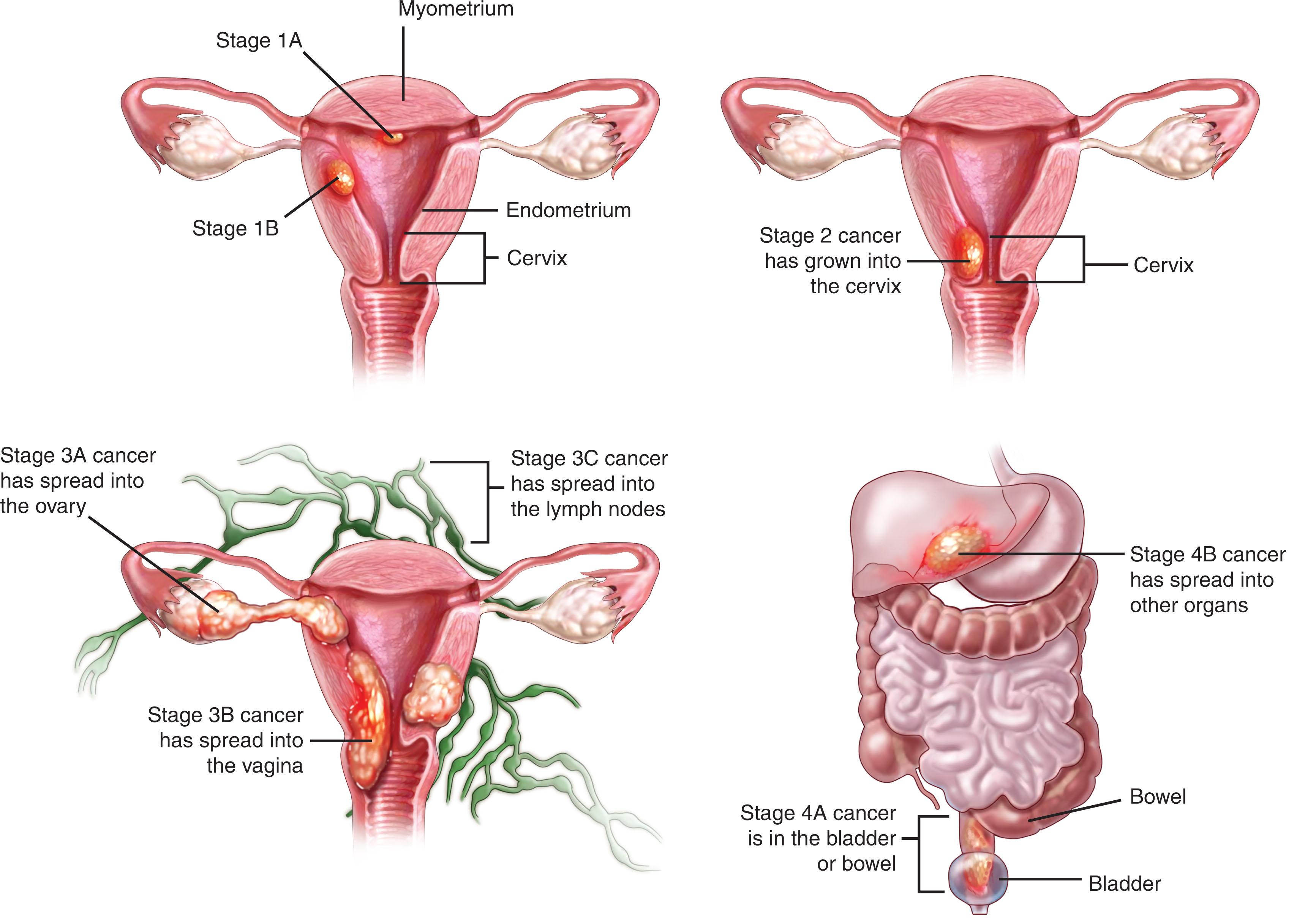
Various imaging modalities are used to evaluate the patient with endometrial cancer preoperatively, postoperatively, and during surveillance ( Figs. 25.2 to 25.12 ). These include ultrasound, MRI, CT, PET/CT, and PET/MRI.
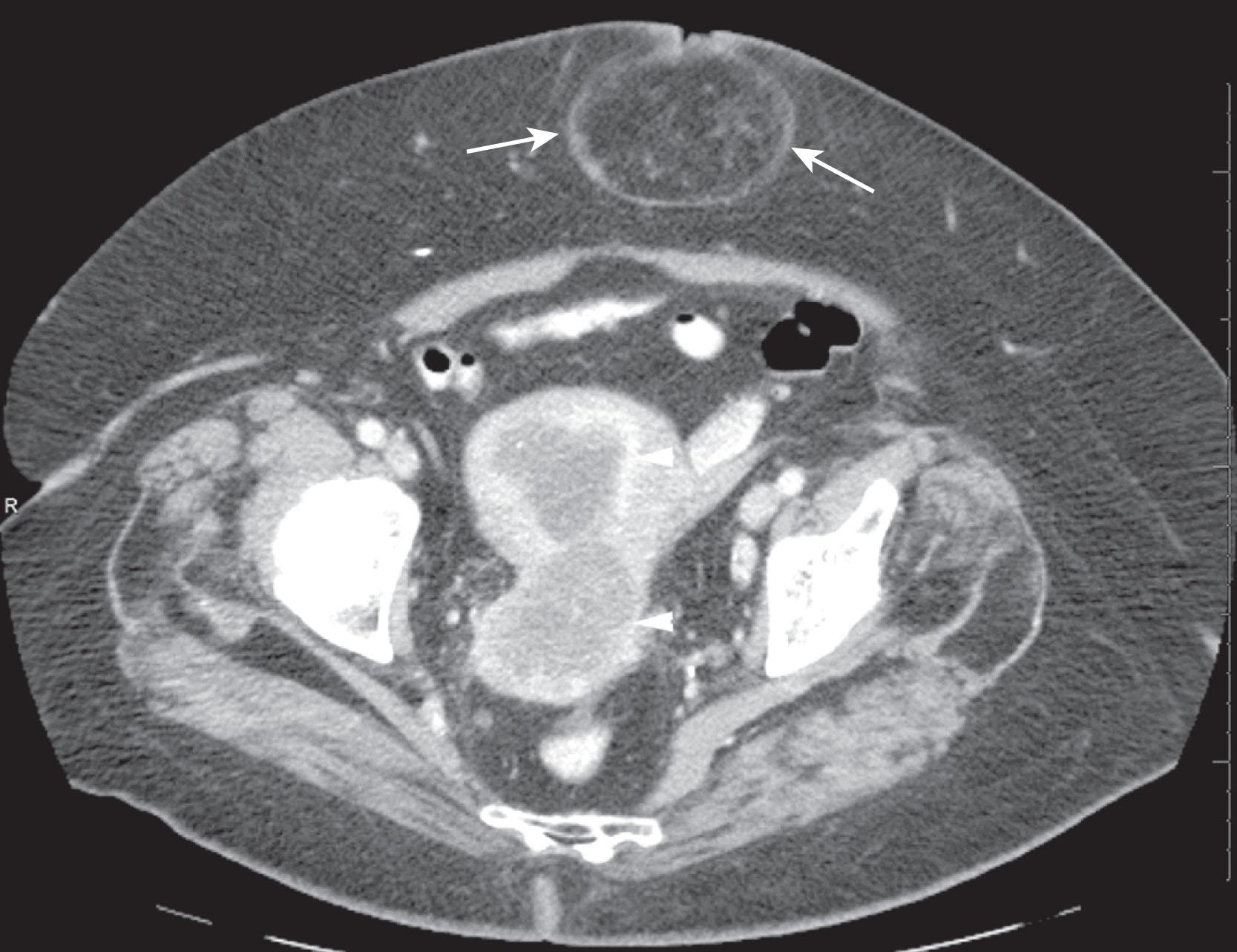
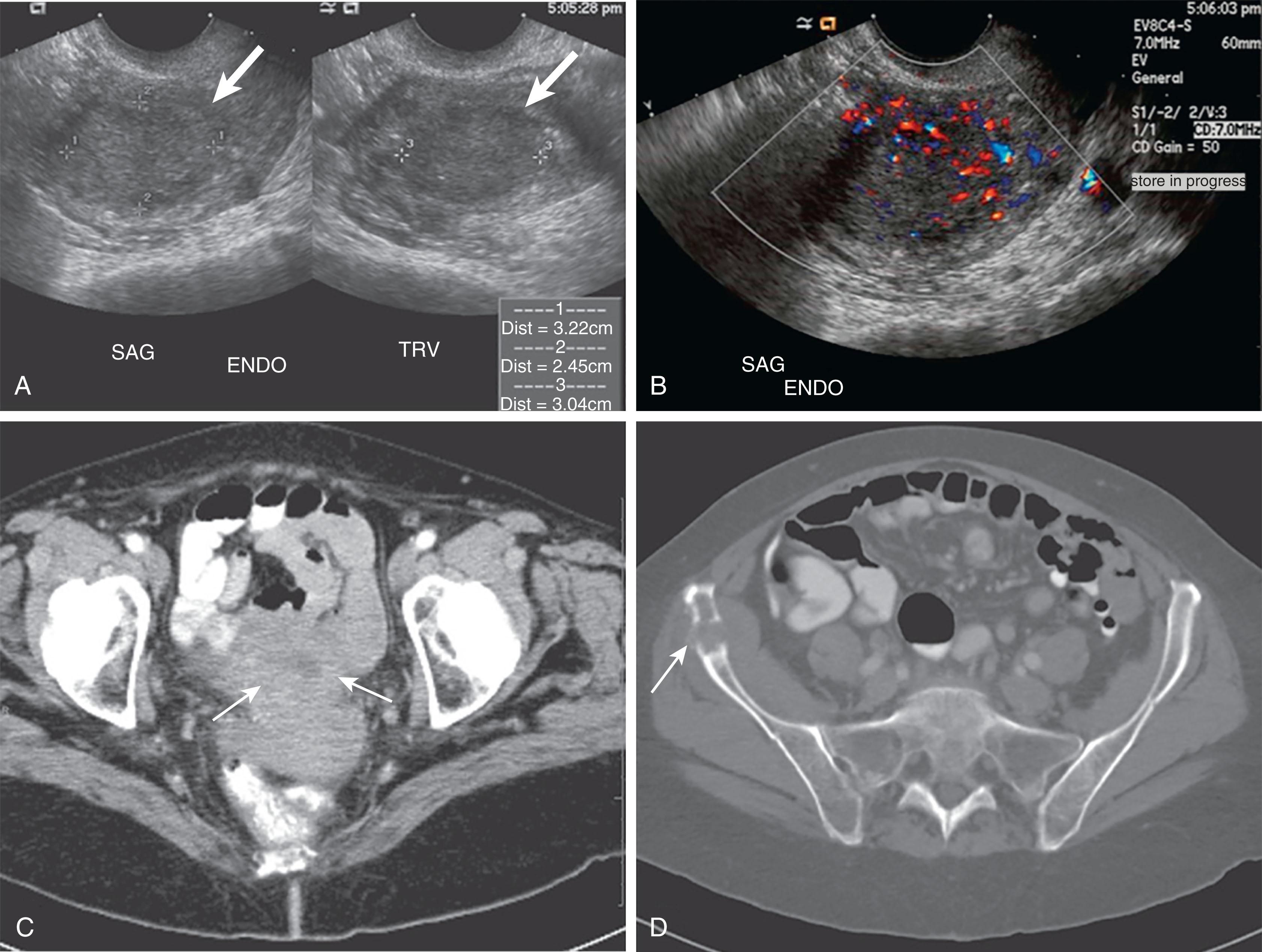
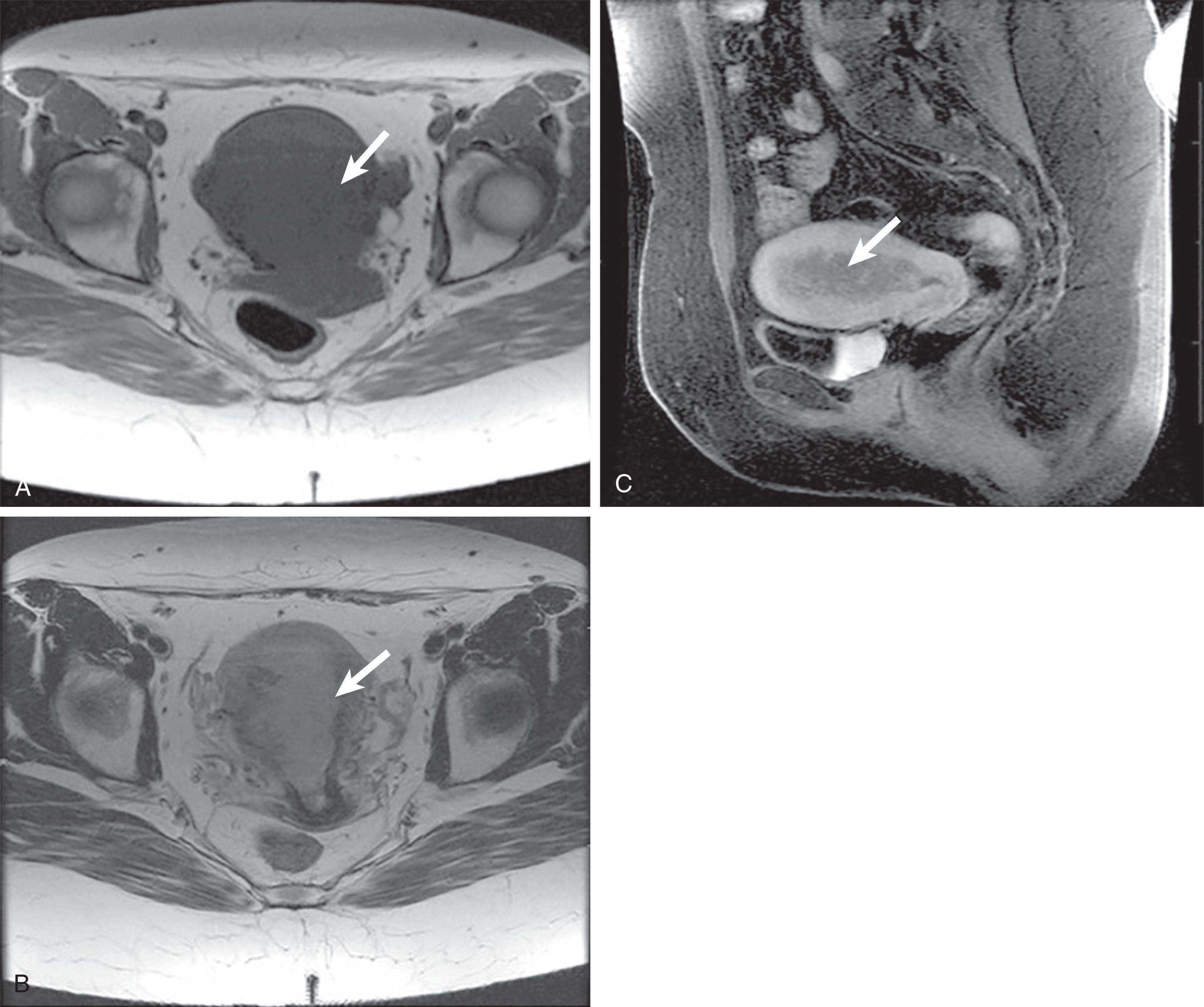
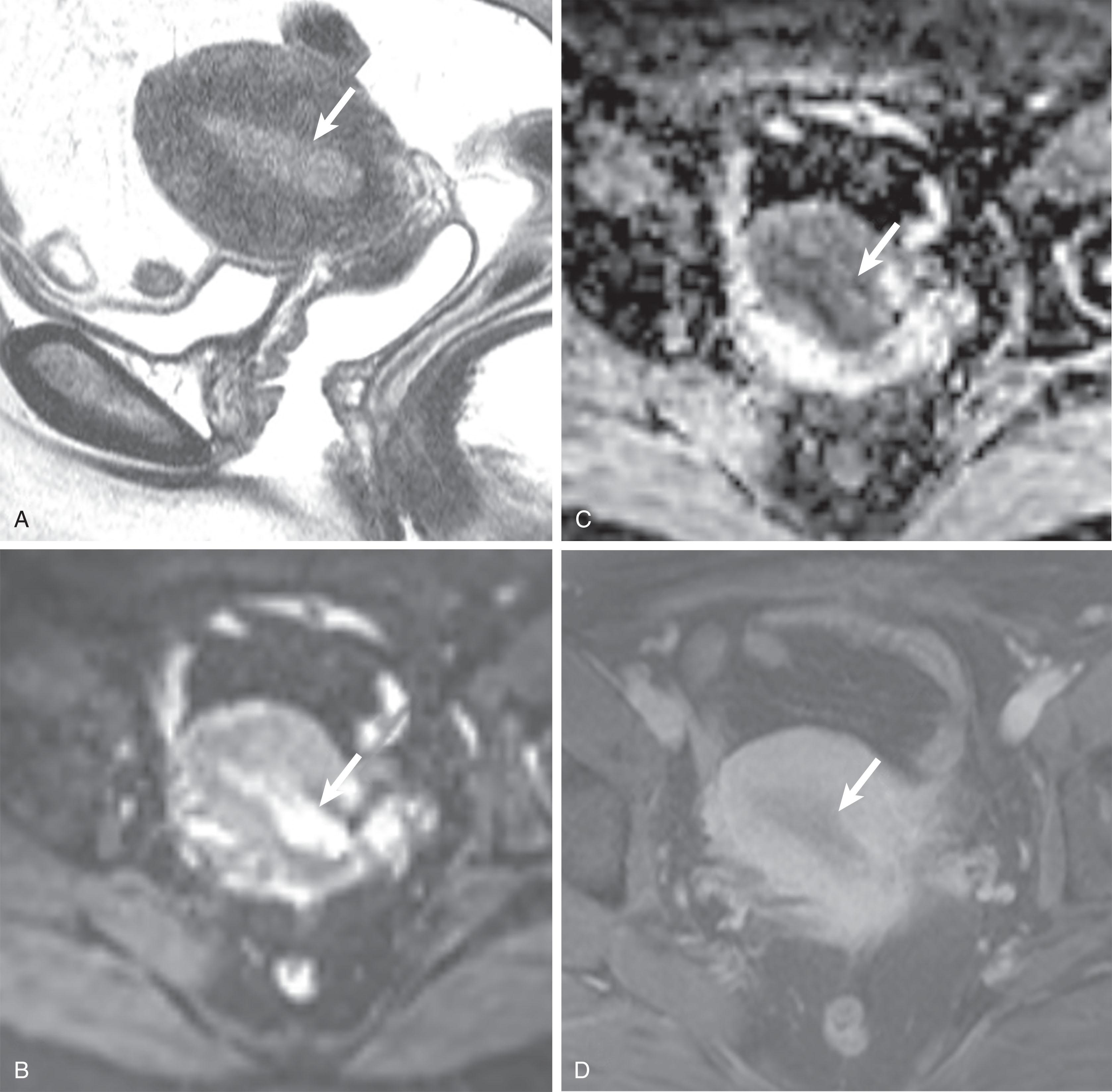
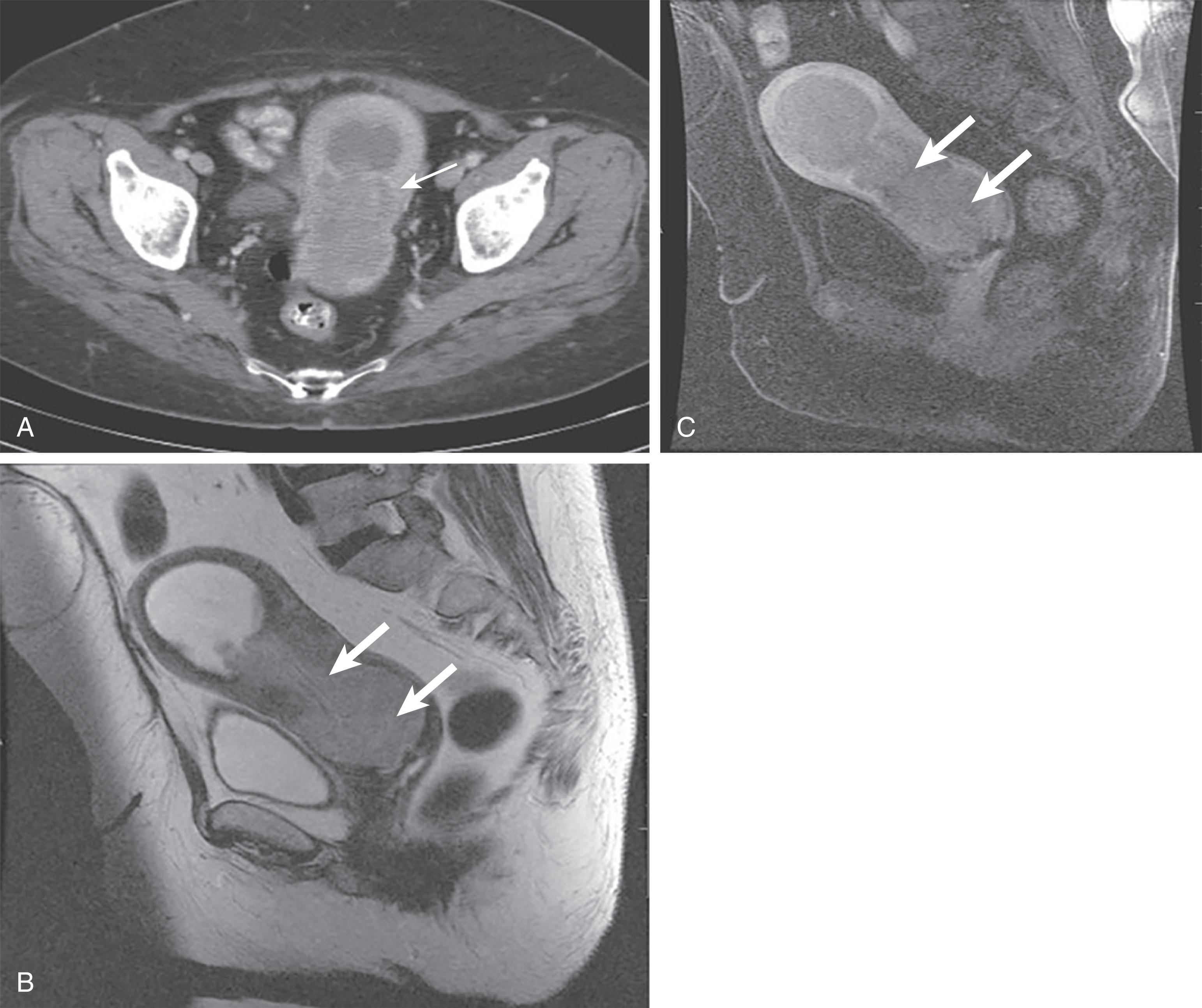
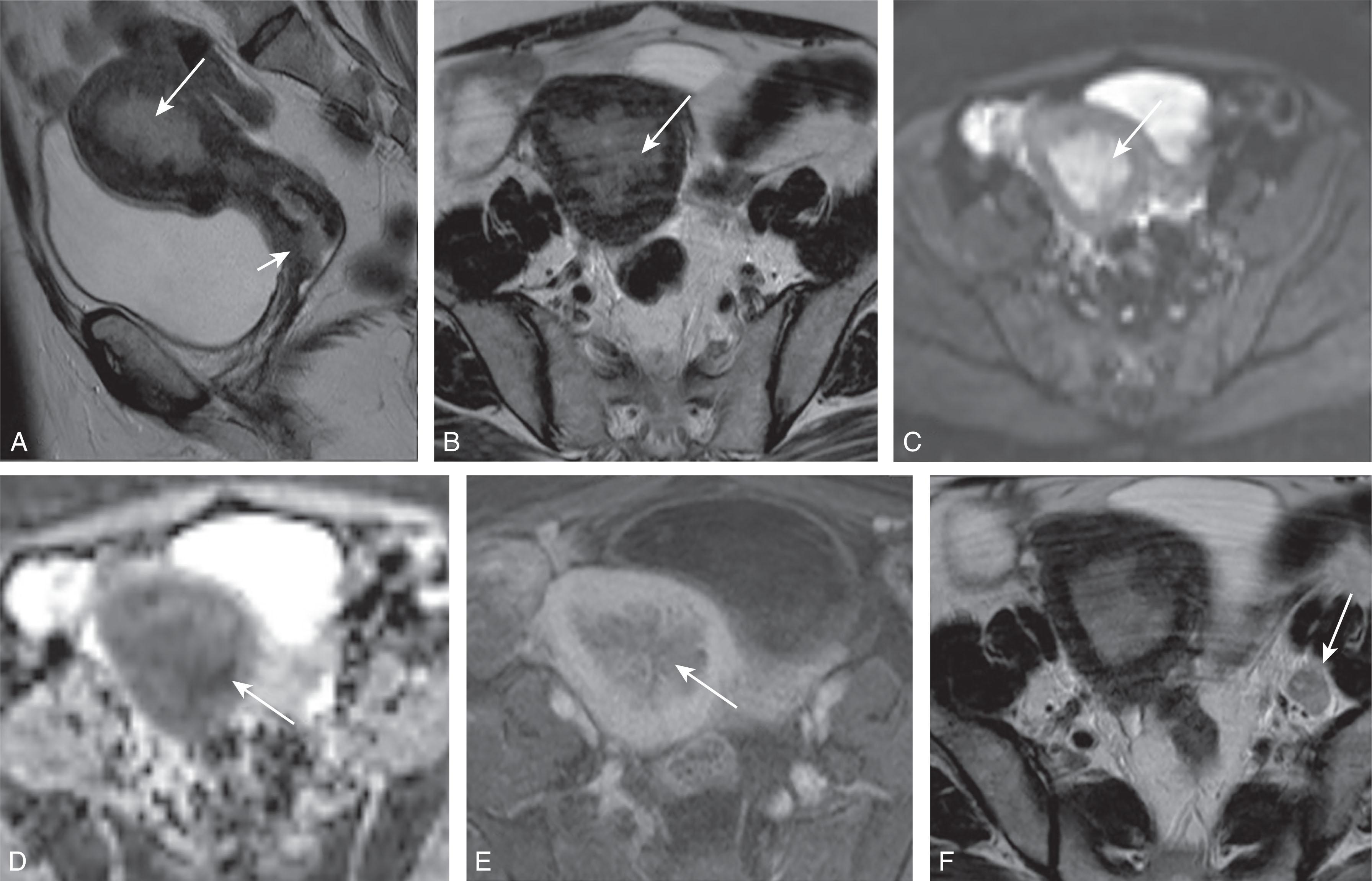
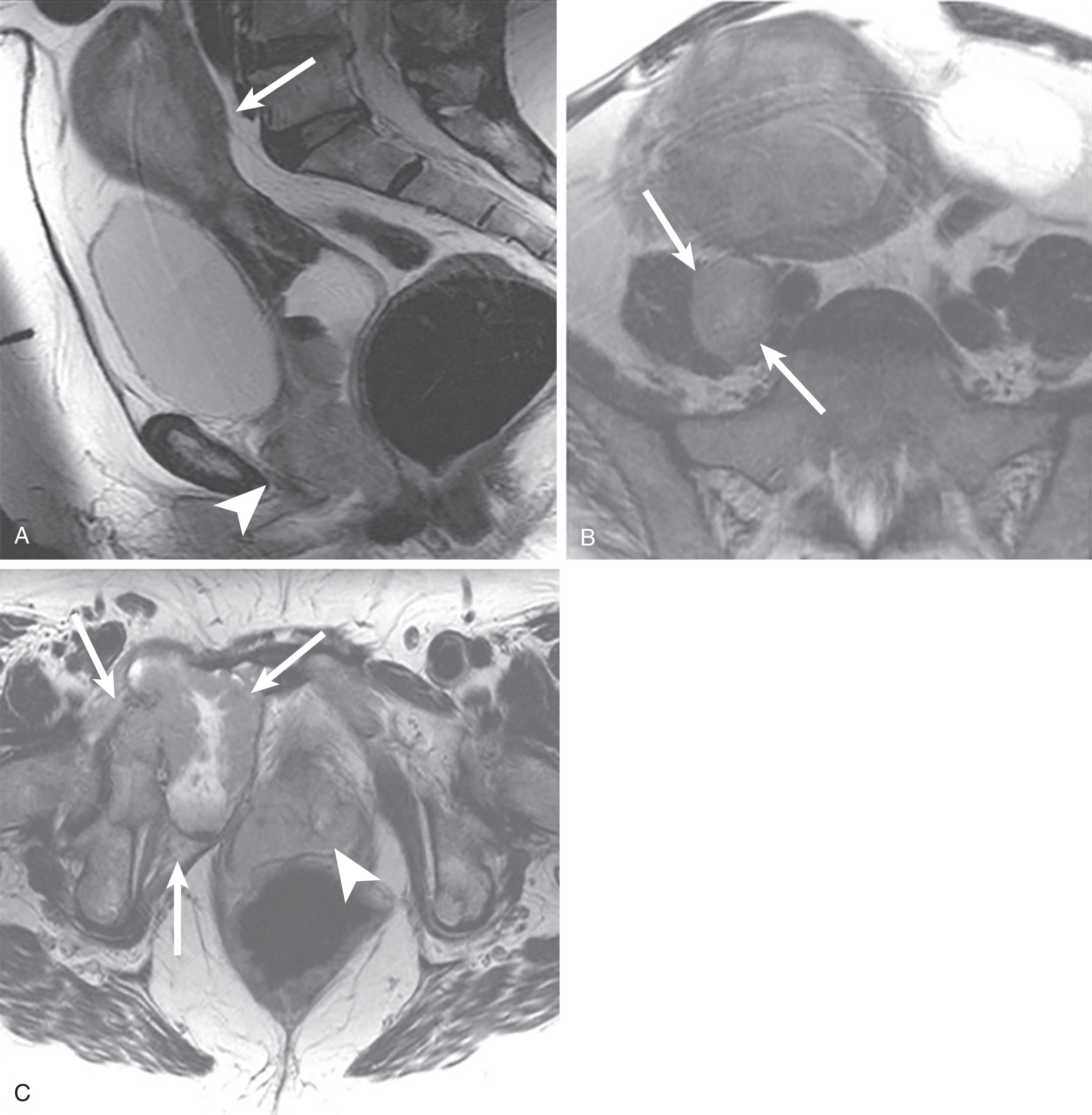
![Fig. 25.9, A 61-year-old woman with prior history of endometrial carcinoma, status posthysterectomy, now presenting with abnormal vaginal bleeding, suspicious for recurrence. A solid mass at the apex of the vaginal cuff was found on clinical examination. A , 2-[ 18 F] fluoro-2-deoxy-D-glucose positron emission tomography (PET)/computed tomography (CT) demonstrates a hypermetabolic right upper lobe lung mass ( white arrow ), consistent with metastatic disease. B , CT with lung windows demonstrates the right upper lobe metastasis ( white arrow ). C , PET/CT scan shows a focal area of increased metabolic activity in the vaginal cuff, consistent with recurrent disease ( white arrow ). D , Contrast-enhanced CT scan delineates the solid mass (white arrows) at the apex of the vaginal cuff. Fig. 25.9, A 61-year-old woman with prior history of endometrial carcinoma, status posthysterectomy, now presenting with abnormal vaginal bleeding, suspicious for recurrence. A solid mass at the apex of the vaginal cuff was found on clinical examination. A , 2-[ 18 F] fluoro-2-deoxy-D-glucose positron emission tomography (PET)/computed tomography (CT) demonstrates a hypermetabolic right upper lobe lung mass ( white arrow ), consistent with metastatic disease. B , CT with lung windows demonstrates the right upper lobe metastasis ( white arrow ). C , PET/CT scan shows a focal area of increased metabolic activity in the vaginal cuff, consistent with recurrent disease ( white arrow ). D , Contrast-enhanced CT scan delineates the solid mass (white arrows) at the apex of the vaginal cuff.](https://storage.googleapis.com/dl.dentistrykey.com/clinical/TumorsoftheUterineCorpus/8_3s20B9780323695381000252.jpg)
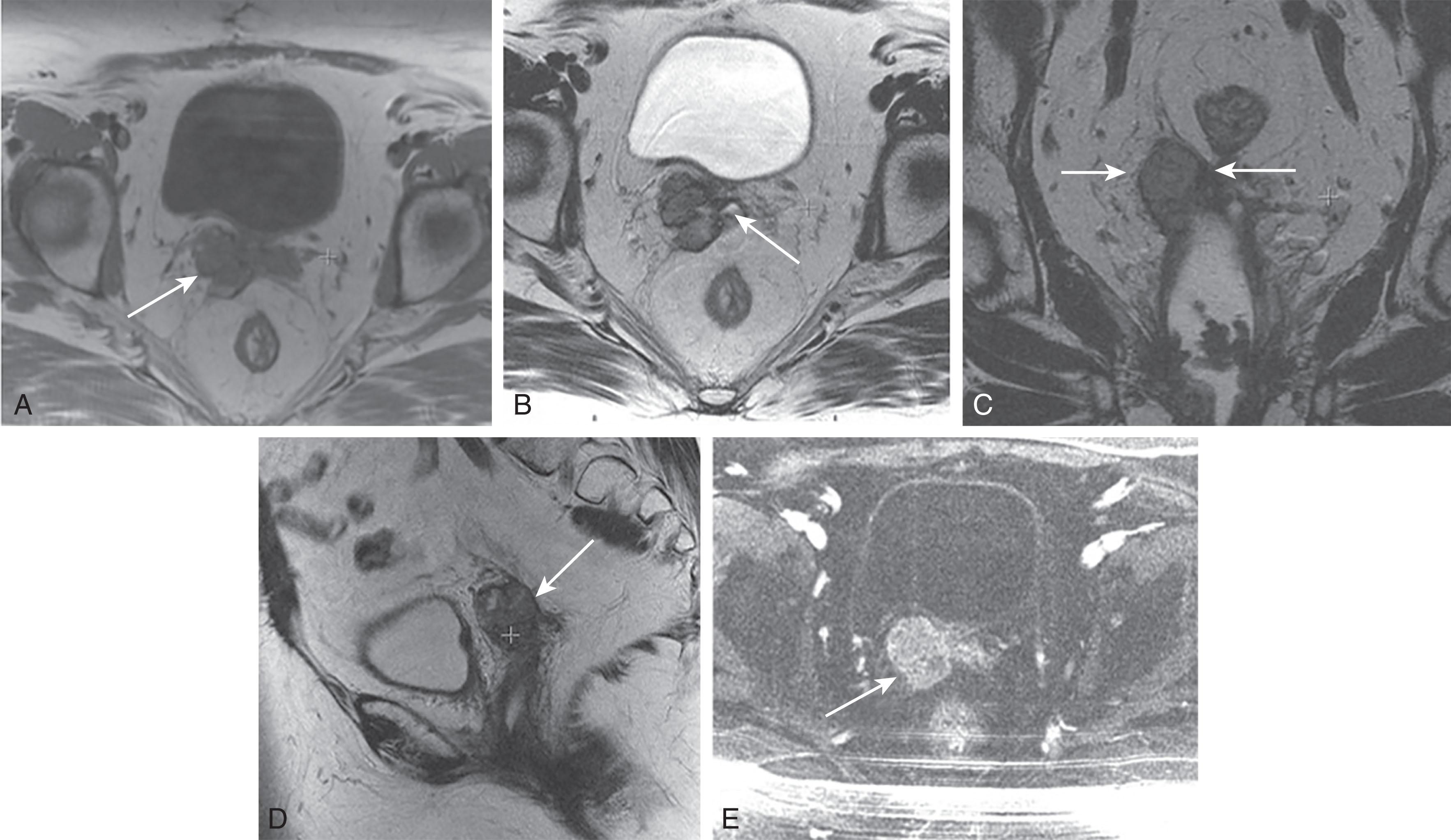
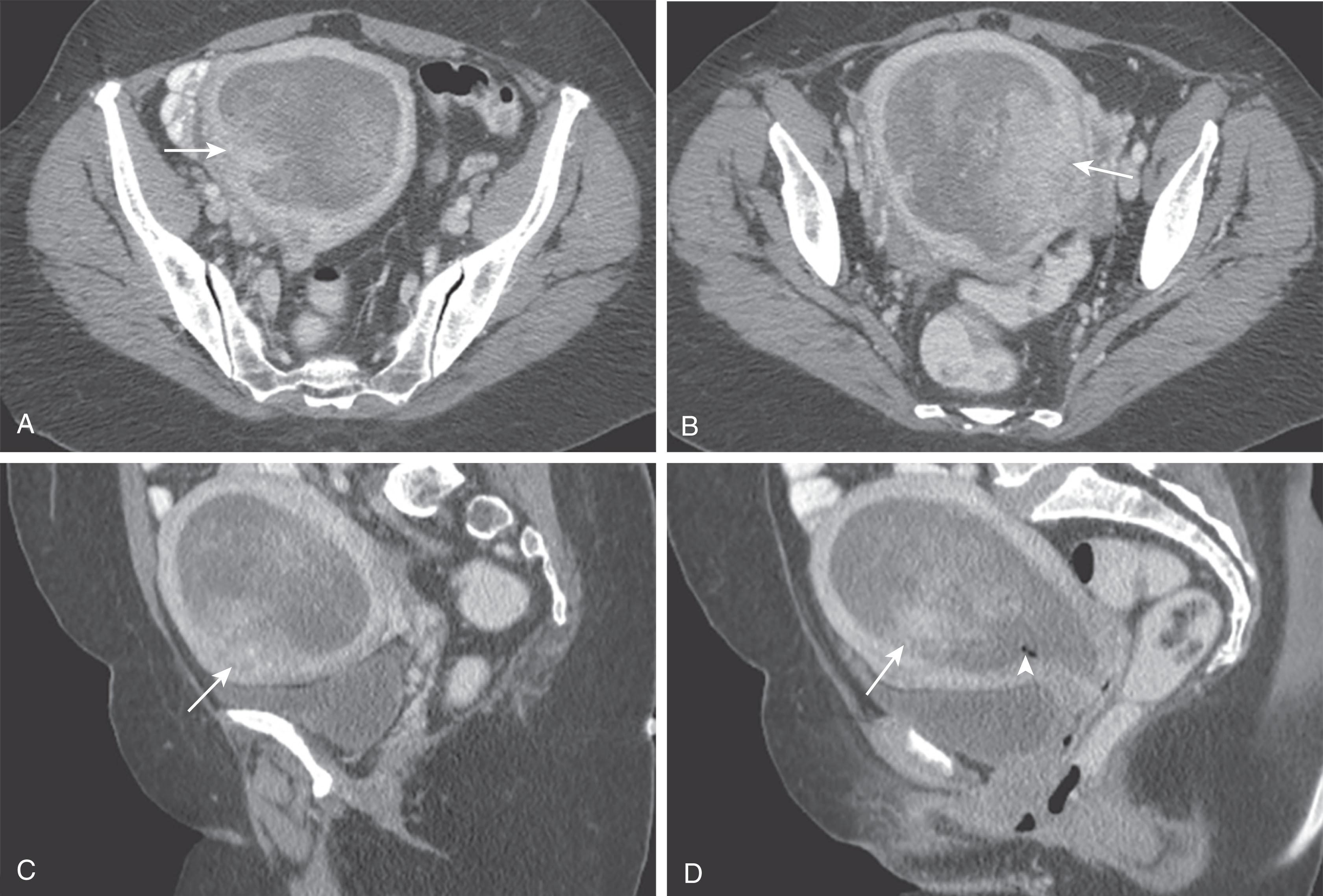
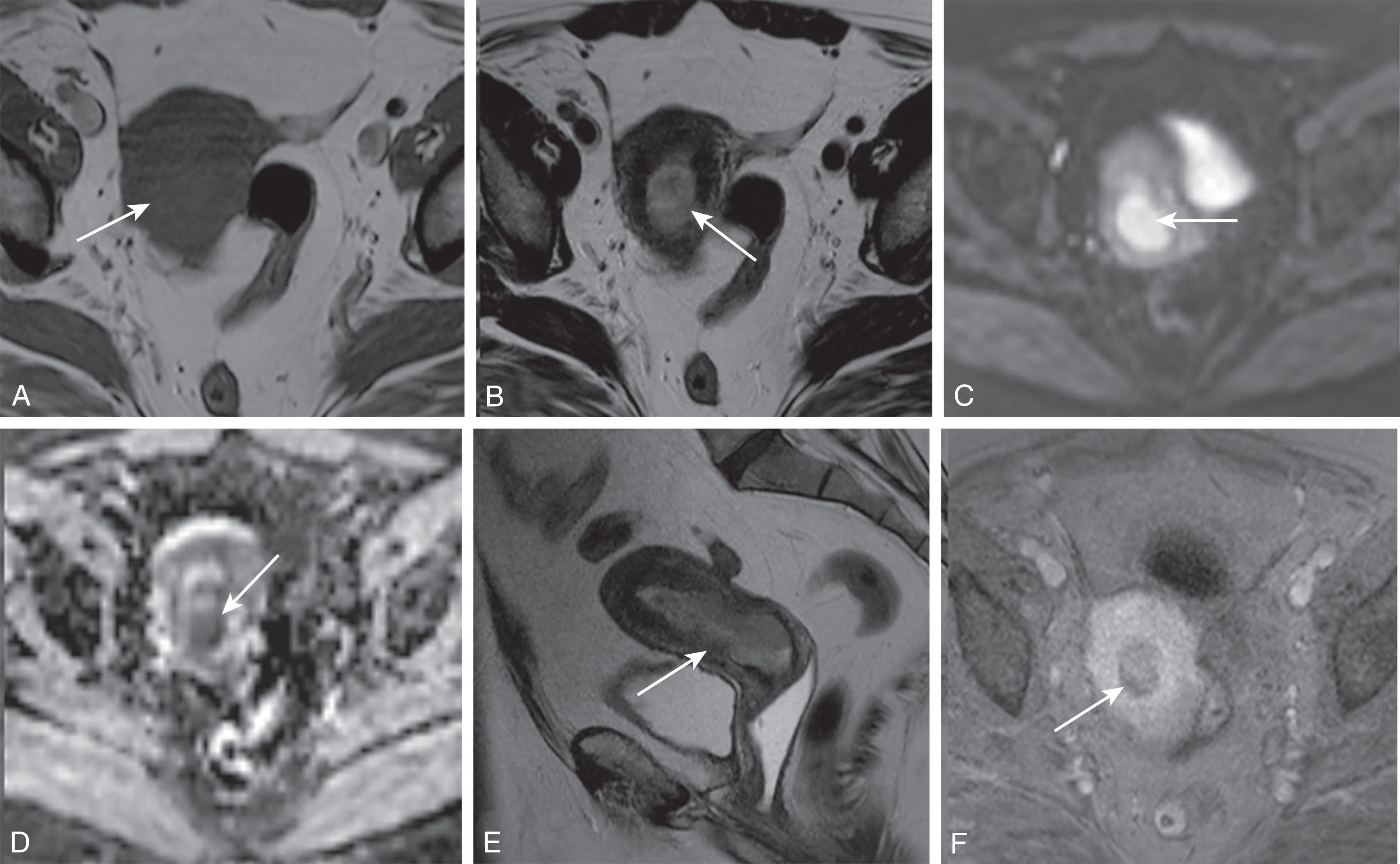
Pelvic and transvaginal ultrasound are routinely used as the first-line imaging modality to assess postmenopausal patients with abnormal vaginal bleeding. A dual-layer endometrial thickness measurement on ultrasound of less than 5 mm in a postmenopausal woman has been previously noted to have a sensitivity of 96% and specificity of 61% for the detection of endometrial cancer. Ultrasound can, to an extent, evaluate the depth of myometrial invasion, with a prior metaanalysis of 184 publications indicating a pooled sensitivity of 82% and specificity of 82% for the presence of deep myometrial invasion. However, ultrasound cannot assess for tumor spread to adjacent organs. Sonohysterography can help to differentiate endoluminal mural masses from a more diffuse and uniformly thickened endometrium.
Become a Clinical Tree membership for Full access and enjoy Unlimited articles
If you are a member. Log in here